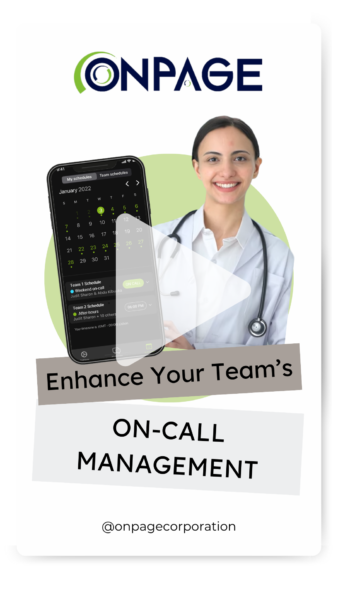Physician On Call Schedule: How to Create an Effective, Fair & Reliable Call System

Providing continuous, high-quality care takes more than clinical expertise—it depends on well-designed physician on call schedules that balance patient safety, physician wellness, and operational efficiency. Whether you manage a residency program or a multi-specialty group, creating an effective physician call schedule—or a broader provider on call schedule—is critical for 24/7 coverage and clinician well-being.
This guide draws on real-world lessons from hospitals and residency programs using OnPage, highlights common pitfalls to avoid, and shows how dedicated physician on call scheduling software can modernize outdated processes. While the focus is on physicians, these best practices apply equally when building a provider on call schedule for multidisciplinary care teams, including nurse practitioners, physician assistants, emergency medicine attending, and other licensed providers who also share after-hours responsibilities.
Why Physician On Call Scheduling Matters
A physician on call schedule lays out which doctors cover urgent and emergent care outside of regular hours. A strong schedule:
-
Guarantees patients can reach the right specialist at any time
-
Protects physicians from fatigue and burnout
-
Ensures compliance with duty-hour limits set by organizations like the ACGME
-
Reduces coverage gaps and costly overtime
When schedules are poorly planned—say, by assigning back-to-back overnight shifts or ignoring physicians’ family or research commitments—the result is predictable: exhausted doctors, higher risk of clinical errors, and low morale.
Real-World Example: From Paper and Pagers to a Single Source of Truth

For years, they relied on Excel sheets and paper schedules, which were hard to maintain and almost impossible to keep version-controlled. Pager reliability was another headache—missed alerts and late responses put patients at risk and caused constant stress.
By adopting OnPage’s physician on call scheduling software, the residency program gained a single, secure platform for both scheduling and communications.
Since the switch:
-
Call schedules update in real time with automatic notifications
-
Alerts and messages route directly to the right on-call provider without manual intervention
-
Residents and attending physicians have peace of mind knowing they will never miss a critical page—even if their phones are on silent
The result? Faster response times, fewer missed calls, and a calmer, more predictable on-call experience.
What Physicians and Administrators Are Saying
The improvement isn’t just on paper.
OnPage’s reliability and ease of use are reflected in public feedback:
“Whenever I am on-call at the hospital, I am easily reachable through OnPage. The notifications are loud and always wake me up even if I am called in at night. It has made my on-call experience much better because I could stop worrying about if I am going to miss a call if my phone is on silent.” — Verified User in Hospital & Health Care, G2
“It’s really clear and easy to understand while also giving you all the necessary information you need. All it takes is downloading the app and logging in… It’s made being on-call a much smoother and less stressful process.” — Trae C., G2 Review
This lived experience shows that technology plus thoughtful scheduling design can meaningfully improve both patient outcomes and provider well-being.
Key Principles for an Effective Physician Call Schedule
Creating an effective schedule requires more than simply filling time slots.
Successful physician call scheduling blends fairness, compliance, and real-world constraints.
Build in Recovery Time
Back-to-back overnight shifts or long stretches of call duty are a recipe for burnout.
Follow guidelines like the ACGME duty-hour limits and ensure every physician has adequate rest between shifts.
Incorporate Physician Input
Invite doctors to share preferences and constraints—family obligations, continuing education, or research commitments—so the schedule respects their professional and personal lives.
Ensure Specialty Coverage
Every shift must have the right mix of specialists.
Use data on patient volumes and seasonal demand to plan ahead.
Maintain Fairness
Rotate nights, weekends, and holidays equitably.
A transparent policy reduces resentment and strengthens team cohesion.
Common Scheduling Pitfalls and How to Avoid Them
Hospitals often stumble by:
-
Assigning back-to-back overnight calls without mandatory recovery periods
-
Ignoring physicians’ personal or academic commitments
-
Publishing schedules late, making life planning difficult
-
Using outdated tools (paper or static spreadsheets) that can’t prevent double bookings or alert failures
Addressing these risks early—especially with real-time, role-based scheduling software—helps ensure seamless patient coverage and physician satisfaction.
The Role of Physician On Call Scheduling Software
While spreadsheets can work for small practices, they don’t scale to complex rotations or provide reliable communication.
Modern physician on call scheduling software offers major advantages:
-
Automated conflict detection to prevent double-bookings and ensure duty-hour compliance
-
Real-time updates that instantly alert the right on-call provider when a shift changes
-
Role-based alert routing so critical messages automatically reach the correct specialist
-
Integration with clinical systems like EHRs, nurse call systems, and collaboration tools such as Microsoft Teams and Slack (bi-directionally through OnPage’s public API)
-
Escalation workflows to guarantee unanswered alerts quickly reach the next on-call provider
These features transform on-call management in healthcare from a manual chore to a reliable, auditable process that supports both patients and providers.
Measuring Success
Evaluate your physician call schedule using concrete metrics:
-
Time to respond to urgent pages
-
Number of missed calls or scheduling conflicts
-
Physician satisfaction and burnout indicators
-
Overtime or unplanned coverage
Regular review helps you refine schedules and demonstrate compliance with internal policies and external standards like AMA recommendations for physician well-being.
Conclusion: From Manual to Modern
An effective physician on call schedule isn’t just a staffing document—it’s a patient safety strategy and a cornerstone of physician wellness.
By applying these best practices and leveraging modern physician on call scheduling software, healthcare organizations can:
-
Ensure round-the-clock patient coverage
-
Protect physicians from fatigue and burnout
-
Comply with duty-hour and contractual requirements
-
Guarantee that critical alerts always reach the right provider
For hospitals, clinics, and residency programs ready to leave behind spreadsheets and unreliable pagers, OnPage delivers a secure, integrated, and proven solution.
Frequently Asked Questions (FAQ)
What is a physician on call schedule?
It’s a structured plan that ensures qualified physicians are available for urgent or emergency care during nights, weekends, and holidays.
How often should physicians take call?
It varies by specialty and institution, but fairness and compliance with duty-hour restrictions are key.
Why use physician on call scheduling software instead of spreadsheets?
Software automates conflict detection, handles swaps, and integrates with clinical communication systems to guarantee timely response.
Can OnPage replace pagers for physician on call scheduling?
Yes. OnPage provides HIPAA-compliant secure messaging, escalation policies, and alert-until-read notifications that outperform traditional pagers.
Is a provider on call schedule different from a physician on call schedule?
Not really—the core principles are the same. A provider on call schedule simply broadens the scope beyond physicians to include other licensed clinicians such as nurse practitioners, physician assistants, and advanced practice providers who also share after-hours responsibilities. The goals remain identical: ensure 24/7 patient coverage, prevent burnout with fair rotations and adequate rest, and streamline communication with reliable escalation and alerting. Whether you call it a physician or provider on call schedule, the need for accurate, real-time scheduling and dependable critical alerting—capabilities that OnPage delivers—doesn’t change.






